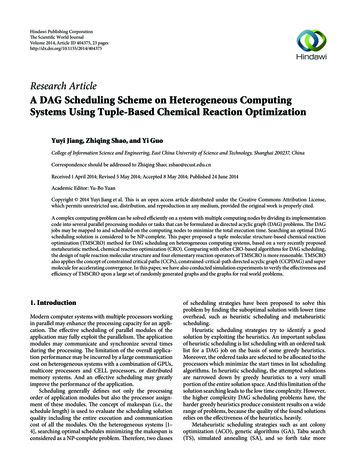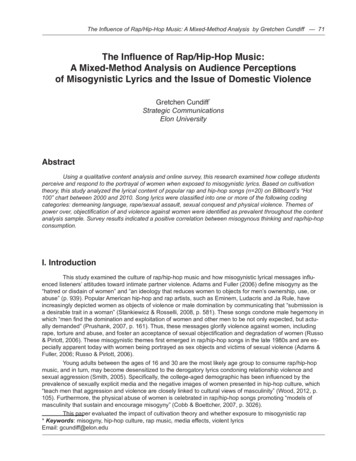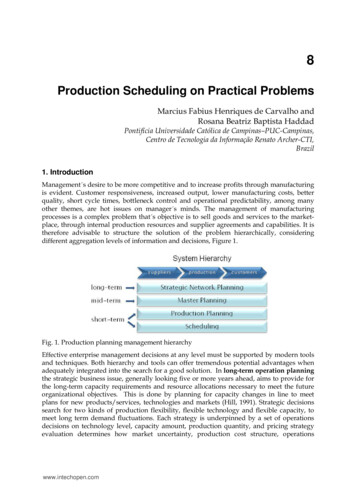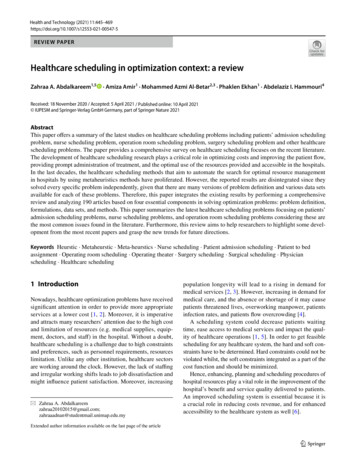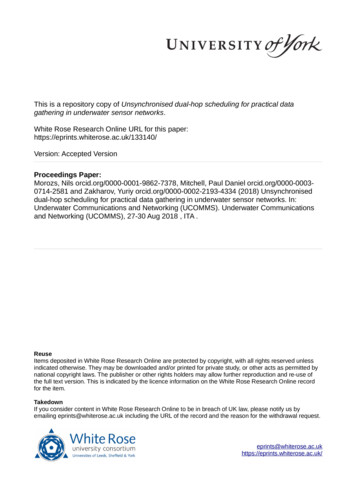
Transcription
This is a repository copy of Unsynchronised dual-hop scheduling for practical datagathering in underwater sensor networks.White Rose Research Online URL for this on: Accepted VersionProceedings Paper:Morozs, Nils orcid.org/0000-0001-9862-7378, Mitchell, Paul Daniel orcid.org/0000-00030714-2581 and Zakharov, Yuriy orcid.org/0000-0002-2193-4334 (2018) Unsynchroniseddual-hop scheduling for practical data gathering in underwater sensor networks. In:Underwater Communications and Networking (UCOMMS). Underwater Communicationsand Networking (UCOMMS), 27-30 Aug 2018 , ITA .ReuseItems deposited in White Rose Research Online are protected by copyright, with all rights reserved unlessindicated otherwise. They may be downloaded and/or printed for private study, or other acts as permitted bynational copyright laws. The publisher or other rights holders may allow further reproduction and re-use ofthe full text version. This is indicated by the licence information on the White Rose Research Online recordfor the item.TakedownIf you consider content in White Rose Research Online to be in breach of UK law, please notify us byemailing eprints@whiterose.ac.uk including the URL of the record and the reason for the withdrawal terose.ac.uk/
Unsynchronized Dual-Hop Scheduling for PracticalData Gathering in Underwater Sensor NetworksNils MorozsPaul MitchellYuriy ZakharovDepartment of Electronic EngineeringUniversity of YorkYork, UKnils.morozs@york.ac.ukDepartment of Electronic EngineeringUniversity of YorkYork, UKpaul.mitchell@york.ac.ukDepartment of Electronic EngineeringUniversity of YorkYork, UKyury.zakharov@york.ac.ukAbstract—In this paper, we propose a centralized dual-hopscheduling approach for efficient and practical data gatheringin underwater acoustic sensor networks - Sequential Dual-HopTransmit Delay Allocation MAC (SDH-TDA-MAC). The practicaladvantages of this approach include scalability to large networks,little control overhead, no requirement for clock synchronizationand low energy consumption and computational complexity.BELLHOP-based simulations reveal that our proposed protocolcan achieve full network connectivity with 15 dB lower transmitpower, compared with standard single-hop TDA-MAC, while stillachieving network throughput in excess of 50% of the theoreticalmaximum. Furthermore, a comparison with sequential pollingshow that our proposed protocol can facilitate multiple timesfaster data gathering by utilizing TDA-MAC for all many-to-oneconnections at the surface gateway and relay nodes.Index Terms—Medium Access Control, TDA-MAC, Underwater Acoustic Network, Wireless SensingI. I NTRODUCTIONThe use of wireless sensor networks (WSNs) for remotemonitoring of the ocean environment is becoming an increasingly popular research subject, owing to the moderndevelopments in underwater acoustic modem technologies [1][2]. It is investigated as a solution to a range of environmentalmonitoring tasks, such as water pollution measurements [3],fish tracking [4], seismic monitoring [5], etc. The WSNapproach to ocean monitoring provides significant advantagesover the traditional deployment of data logging sensor nodesfrom dedicated ships, because WSNs allow flexible long termdeployments and eliminate the need to retrieve the sensornodes from the sea bed in order to collect the data.In contrast with terrestrial wireless communication systems,underwater radio propagation is severely limited in rangedue to high absorption of electromagnetic (EM) waves inseawater, while optical communications suffer from both highabsorption and optical scattering [6]. Acoustic waves are thepreferred practical medium of communication in the underwater environment; they exhibit significantly better propagationcharacteristics compared with EM waves. However, acousticcommunications are fundamentally limited by the low soundpropagation speed, approximately 1500 m/s in water, and byThis work is supported by the UK Engineering and Physical SciencesResearch Council (EPSRC) through the USMART Project under GrantEP/P017975/1.low bandwidth with carrier frequencies typically limited totens of kHz, or lower for long range transmissions [2] [6].The long propagation delays of acoustic signals presenta significant challenge in Medium Access Control (MAC),i.e. coordinating transmissions of multiple acoustic communication nodes potentially spaced kilometres apart from oneanother. Much of the well-established research on MAC inunderwater acoustic networks (UANs) focuses on schedulebased TDMA protocols. There, the nodes are scheduled totransmit their data packets in particular time slots such thatthe packets arrive at the intended receivers without collisions,e.g. [7] [8] [9]. Schedule-based MAC schemes do not involvecontention for communication resources, thus removing theneed for control signalling, e.g. Request-to-Send (RTS), Clearto-Send (CTS), acknowledgements etc., in order to establishcollision-free links. Therefore, they are capable of achievinghigh throughput by efficiently scheduling transmissions in away that results in a stream of data packets separated byguard intervals at the intended receivers. The drawback ofsuch coordinated scheduling protocols is their need for clocksynchronization across different nodes, which is a challengingtask in UANs due to long propagation delays, noisy timevarying multipath channels, and the signaling overhead thatis not negligible compared with terrestrial radio systems [2][10]. The use of chip-scale atomic clocks is an alternativeway of providing an accurate synchronized time reference tothe network nodes for long periods of time, but they are notfeasible in many scenarios, in particular due to their excessivecost, higher power consumption and ageing [11] [12].In this paper we consider the problem of scheduled datagathering in large networks of low cost, low specificationsensor nodes that are currently being investigated in theEPSRC ”Smart dust for large scale underwater wireless sensing (USMART)” project [13]. In particular, we focus ondesigning a practical MAC protocol with the following keyproperties: scalability to large networks (up to hundreds of nodes),no requirement for clock synchronization,little control signalling overhead,low energy consumption,low computation requirements.
SensorREQDATA 1ox linkNode 1Node 2Node 3Sensor nodeFig. 1. Underwater wireless sensor network deployment with sensor nodeson the sea bed and a surface buoy used as the gateway node.To this end we propose the Sequential Dual-Hop TransmitDelay Allocation MAC (SDH-TDA-MAC) approach to datagathering in UANs, improving on our previous work on thesingle-hop TDA-MAC protocol [14] that was designed withthe same practical considerations as above. The key featurethat separates SDH-TDA-MAC from TDA-MAC is that theformer can operate in dual-hop topologies, thus dramaticallyreducing node outage due to acoustic shadows and surfacenode’s limited coverage, and improving energy efficiency byusing shorter links at lower transmit power.The rest of the paper is organized as follows: Section IIintroduces the TDA-MAC protocol and its application to datagathering in UANs; Section III extends this protocol to a dualhop setting and gives details of the SDH-TDA-MAC protocolproposed in this paper; Section IV evaluates the performanceof the proposed protocol using a detailed simulation model;finally, Section V concludes the paper.II. DATA G ATHERING IN UAN S U SING TDA-MACFig. 1 shows a typical underwater WSN deployment scenario that is considered in this study. There, a buoy is used asthe surface gateway node to gather the readings from sensornodes deployed on the sea bed via acoustic communications,and to relay these sensor readings to an on-shore base stationvia a wireless radio link.In [14] we proposed the TDA-MAC protocol for centralizedscheduling of data transmissions from sensor nodes connectedto the same gateway node, such as in the scenario depicted inFig. 1. Its main advantage over other MAC protocols found inthe literature is that it can achieve network throughputs closeto the maximum channel capacity, while not requiring clocksynchronization or any other advanced functionality at thesensor nodes. Therefore, it shows great potential as a practicalsolution for efficient data gathering in UANs. Fig. 2 givesa simple example that shows the packet flow in TDA-MAC.There, the gateway node transmits a broadcast data request(REQ) packet that is received by every sensor node at adifferent time (due to long propagation delays of acousticlinks). Each sensor node then waits for a specific (individuallyDATA 3ᶦ [p 3]ᶦ [p 1]TdpNDATA 2Trpᶦ [p 2]GatewayNodeBuoy with radio andacoustic linksdataTerrestrialbase stationDATA 1REQREQᶦtx [2]REQDATA 2ᶦtx [3]DATA 3Fig. 2. TDA-MAC packet flow example, where a single gateway node gathersdata from 3 sensor nodes [14].assigned) amount of time before transmitting their data packetback to the gateway node.The gateway node assigns a transmit delay to every individual sensor node using the following iterative equation:τtx [n] τtx [n-1] Tdp [n-1] Tg [n-1] 2(τp [n] τp [n-1]),(1)where τp [n] is the estimated propagation delay from thegateway node to the nth sensor node, τtx [n] is the transmitdelay assigned to the nth sensor node, τtx [1] 0, i.e. thefirst node starts transmitting its data packet as soon as itreceives the REQ packet from the gateway node, Tdp [n] isthe duration of the nth node’s data packet and Tg [n] is theguard interval after the nth node’s data packet reception at thegateway node. The nodes in the τtx (τtx [1], τtx [2], ., τtx [N ])and τp (τp [1], τp [2], ., τp [N ]) vectors are sorted from theshortest to the longest propagation delay from the gatewaynode. In some cases, transmit delays calculated using (1) maybe negative. Then they are set to zero before continuing toiterate over the rest of the nodes in τtx .The guard interval Tg [n] is an important design parameterthat is used to avoid packet collisions due to inaccuracies inpropagation delay estimates, slow variations in node positionsand the multipath spread. For example, in this paper we use a100 ms guard interval which can tolerate approximately up to150 m changes in relative node positions before the transmitdelays have to be adjusted to compensate for the drift.The only prerequisite for implementing TDA-MAC is theknowledge of propagation delays between the gateway nodeand every sensor node, which can be measured using a sequence of ping signals during the initial network deployment.Afterwards, during the normal operation of the network, thegateway node can continuously monitor the accuracy of theestimated propagation delays by measuring the error in thetiming of the received data packets. For full details of theinitialization process and operation of TDA-MAC, see [14].III. S EQUENTIAL D UAL -H OP TDA-MACThe main disadvantage of TDA-MAC is that it requires acentralized single-hop topology, which cannot accommodatenodes outside of coverage of the gateway node, e.g. due toacoustic shadows or if a sensor node is out of range of thegateway node. In this section we propose Sequential Dual-Hop
Startpropagation delay estimation for every link. The details of ourimplementation of these functions are out of the scope of thispaper. However, there are a number of algorithms proposed inthe literature that can achieve this goal, e.g. [15] [16].After all the links and their propagation delays are established, the network employs the SDH-TDA-MAC protocolexplained in Fig. 3. The gateway node gathers data fromevery relay node’s branch of the network sequentially (seeFig. 3a). This avoids packet interference between differentrelay branches due to the space-time uncertainty, at the cost ofa reduction in channel utilization efficiency, which is examinedin the simulation results in Section IV. However, all othertransmissions from sensor nodes to their gateway (Fig. 3a) orrelay node (Fig. 3b) are performed using TDA-MAC describedin Section II, which significantly speeds up the data gatheringprocess compared with individually polling every sensor node.Request data from a relay nodeReceive all data from this node’s branchAre there more relaynodes to query?YesNoSend broadcast data request (REQ) to all non-relay nodesReceive data from all non-relay nodes (TDA-MAC)Keep gathering data?YesNoEnd(a) Implementation at the gateway nodeStartREQ received fromgateway node?NoYesSend broadcast data request (REQ) to all child nodesIV. S IMULATION R ESULTSA. Simulation SetupTable I describes the parameters of the MATLAB modelused for the simulation experiments in this paper. They correspond to a UAN data gathering scenario with 100 low cost,low specification sensor nodes deployed across a 6 6 km areaon the sea bed at 470-490 m depth.TABLE IS IMULATION PARAMETERSReceive data from all child nodes (TDA-MAC)Transmit data from all child nodes and itself to the gateway node(b) Implementation at the relay nodesFig. 3. The Sequential Dual-Hop TDA-MAC protocol. The gateway node firstgathers data from all relay nodes (including their child nodes), and then usesTDA-MAC for the remaining directly connected nodes. Relay nodes employTDA-MAC to gather data from their child nodes.TDA-MAC (SDH-TDA-MAC), an extension of TDA-MAC,that can operate in a dual-hop setting, i.e. those nodes that donot have a direct link with the gateway node can be connectedvia another sensor node that acts as a relay. Therefore, inaddition to scheduling, SDH-TDA-MAC also incorporates therouting process, i.e. managing the hops between sensor nodesto deliver the packets to the gateway node.The advantage of our proposed dual-hop approach, compared with more generic distributed multi-hop MAC protocols,is that limiting the number of hops to two and controlling theentire network operation at a single gateway node reduces theamount of uncertainty about the channel availability and, thus,reduces the amount of control signalling and idle listening timerequired, e.g. RTS/CTS and ACKs. This in turn enables thenetwork to achieve high throughputs atypical for multi-hopUANs, as shown in the results in Section IV.First, the links between the gateway node and all in-rangesensor nodes, and the links between the relay nodes andout-of-coverage sensor nodes, need to be established via thenetwork discovery and localization processes, including theParameterSensor node coverage areaNumber of nodesSea depthSurface node depthSensor node depthFrequency channelTransmit powerChannel bitratePacket sizeSNR threshold for receptionNoise powerChannel modelSound speed profileValue6 6 km100 (uniform random positions)500 m10 mUniform random, 470-490 m24-28 kHz140-170 dB re µPa @ 1 m140 b/s [17]Data: 128 bits, REQ: 32 bits-12 dB [17]Ambient noise model [18], 10 m/s windspeed, 0.5 shipping activity factorBELLHOP with multipath fading [19]Based on average summer data at(56.5o N, 11.5o W) [20]The channel between every pair of nodes was modelledusing the BELLHOP ray tracing program [19], a wellestablished platform for simulating underwater acoustic wavepropagation. For every source-receiver pair, the output ofBELLHOP includes N echoes, each with a spreading lossAspr (n), propagation delay τn and phase shift θn . We thencalculate the linear channel gain as follows:2Z fmax XNj( 2πf (τn τ0 ) θn )Aspr (n) Aabs (n, f ) eG df,fminn 1(2)where fmin and fmax are the minimum and maximum frequencyin the simulated channel, Aabs (n, f ) is the absorption loss ofthe nth echo at frequency f calculated using Thorp’s formula[18], and τ0 is the propagation delay of the first received echo.
1401120Sequential Dual-Hop TDA-MACSequential Polling100Throughput, b/sP(node is ial Dual-Hop TDA-MACSingle-Hop TDA-MAC014080170Transmit power, dB re µPa @ 1mFig. 4. Extending TDA-MAC from single-hop to dual-hop dramaticallyimproves the probability of a node being connected and reduces the transmitpower required to achieve full connectivity.B. Network ConnectivityFig. 4 shows the improvement in network connectivity achieved by SDH-TDA-MAC, compared with single-hopTDA-MAC. A connection between any pair of nodes isassumed to be present if the Signal-to-Noise Ratio (SNR)at the receiver is above the minimum threshold of -12 dB[17]. All datapoints show an average of 50 simulations withdifferent random seeds and node locations, with the error barsrepresenting the 5th and 95th percentiles. The plot shows thatthe sensor nodes can afford to reduce their transmit powerby approximately 15 dB to maintain full network connectivityvia the dual-hop protocol, which can dramatically extend thebattery life and reduce the cost of the sensor nodes. Fig. 4also shows that even in scenarios where roughly 50% of thesensor nodes are out of the gateway node’s communicationrange (149 dB re µPa @ 1 m transmit power), those nodescan establish dual-hop links to achieve full connectivity, thusgreatly improving network coverage.C. Network ThroughputFig. 5 shows how the aggregate throughput from all singlehop and dual-hop connected nodes changes with transmitpower, i.e. ranging from only 25% of the nodes with a singlehop connection to the gateway node to a 100% single-hoptopology. The results at 167-170 dB re µPa @ 1 m show that ina single-hop topology TDA-MAC performs highly efficientlyand achieves 125 b/s throughput, 89% of the total 140 b/schannel capacity, with most of this throughput loss being dueto a purposely designed 100 ms guard interval between thedata packet slots. As the transmission range decreases, theSDH-TDA-MAC protocol is still able to achieve high networkthroughput. For example, at 149 dB re µPa @ 1 m transmitpower, when on average 50% of the nodes are connected viadual-hop links, the network throughput is 73 b/s which is stillmore than 50% of total channel capacity.Fig. 5 also compares the network throughput achieved bythe SDH-TDA-MAC protocol with that provided by sequentialpolling, similar to UW-Polling [21] but optimized for our staticscenario. It works similarly to the flowchart shown in Fig. 3,0140145150155160165170Transmit power, dB re µPa @ 1mFig. 5. Sequential Dual-Hop TDA-MAC achieves signficantly higher datagathering throughput compared with multi-hop sequential polling.but instead of employing TDA-MAC, the gateway and relaynodes gather the data by sequentially polling their child nodes.The plot shows that using TDA-MAC for all direct manyto-one communication links controlled by the gateway andrelay nodes improves network throughput by a factor of 2-4in full network connectivity scenarios, i.e. with transmit power 149 dB re µPa @ 1 m. For example, at 149 dB re µPa @ 1 m,SDH-TDA-MAC is able to collect data from all 100 nodesin just under 3 minutes, whereas it takes sequential pollingover 6 minutes to achieve the same task. At 164 dB re µPa@ 1 m transmit power, when most of the nodes have a directlink with the gateway node, SDH-TDA-MAC can gather dataevery 1 min 45 sec, while the fastest data gathering achievablevia sequential polling is every 7 min 20 sec. This allowsthe underwater sensor network to monitor the environmentconsiderably closer to real-time.V. C ONCLUSIONS AND F URTHER W ORKThe SDH-TDA-MAC protocol proposed in this paper facilitates efficient data gathering in UANs via centralized dualhop scheduling, but without the need for clock synchronization among the sensor nodes. BELLHOP-based simulationsrevealed that SDH-TDA-MAC can achieve full network connectivity with 15 dB lower transmit power, compared withits single-hop counterpart, while still achieving throughputs inexcess of 50% of the theoretical maximum. This is becauseof the spectral efficiency of TDA-MAC employed for allmany-to-one connections at the gateway and relay nodes. Acomparison with sequential polling showed that our proposedprotocol can improve the data gathering speed by a factor of2-4, depending on the number of sensor nodes that are out ofthe surface gateway node’s coverage.In conclusion, the high throughput, low transmit power andno requirement for clock synchronization make SDH-TDAMAC an efficient and practical data gathering approach.Further work includes utilizing more detailed localizationinformation to allow for spatial reuse of the channel at separaterelay nodes, and extending this MAC approach beyond dualhop to an arbitrary number of hops, which will also requiremore sophisticated routing strategies.
R EFERENCES[1] G. Acar and A. E. Adams, “ACMENet: an underwater acoustic sensornetwork protocol for real-time environmental monitoring in coastalareas,” IEE Proceedings - Radar, Sonar and Navigation, vol. 153, no. 4,pp. 365–380, 2006.[2] J. Heidemann, M. Stojanovic, and M. Zorzi, “Underwater sensor networks: applications, advances and challenges,” Philosophical Transactions of the Royal Society of London A: Mathematical, Physical andEngineering Sciences, vol. 370, no. 1958, pp. 158–175, 2011.[3] A. Khan and L. Jenkins, “Undersea wireless sensor network forocean pollution prevention,” in Proceedings of the 3rd InternationalConference on Communication Systems Software and Middleware andWorkshops (COMSWARE), 2008.[4] B. Boom, J. He, S. Palazzo, P. Huang, C. Beyan, H.-M. Chou, F.-P.Lin, C. Spampinato, and R. Fisher, “A research tool for long-term andcontinuous analysis of fish assemblage in coral-reefs using underwatercamera footage,” Ecological Informatics, vol. 23, no. Supplement C, pp.83 – 97, 2014.[5] A. K. Mohapatra, N. Gautam, and R. L. Gibson, “Combined routingand node replacement in energy-efficient underwater sensor networksfor seismic monitoring,” IEEE Journal of Oceanic Engineering, vol. 38,no. 1, pp. 80–90, Jan 2013.[6] L. Lanbo, Z. Shengli, and C. Jun-Hong, “Prospects and problemsof wireless communication for underwater sensor networks,” WirelessCommunications and Mobile Computing, vol. 8, no. 8, pp. 977–994,2008.[7] K. Kredo II, P. Djukic, and P. Mohapatra, “STUMP: Exploiting position diversity in the staggered TDMA underwater MAC protocol,” inProceedings of IEEE INFOCOM, 2009.[8] R. Diamant and L. Lampe, “Spatial reuse time-division multiple accessfor broadcast ad hoc underwater acoustic communication networks,”IEEE Journal of Oceanic Engineering, vol. 36, no. 2, pp. 172–185,2011.[9] S. Lmai, M. Chitre, C. Laot, and S. Houcke, “Throughput-efficientsuper-TDMA MAC transmission schedules in ad hoc linear underwateracoustic networks,” IEEE Journal of Oceanic Engineering, vol. 42, no. 1,pp. 156–174, 2017.[10] N. Chirdchoo, W.-S. Soh, and K. C. Chua, “MU-Sync: A time synchronization protocol for underwater mobile networks,” in Proceedings of theThird ACM International Workshop on Underwater Networks (WuWNet),2008.[11] A. T. Gardner and J. A. Collins, “Advancements in high-performancetiming for long term underwater experiments: A comparison of chipscale atomic clocks to traditional microprocessor-compensated crystaloscillators,” in Proceedings of IEEE OCEANS, 2012.[12] K. Kebkal, O. Kebkal, E. Glushko, V. Kebkal, L. Sebastiao, A. Pascoal,J. Gomes, J. Ribeiro, H. SIlva, M. Ribeiro, and G. Indivery, “Underwateracoustic modems with integrated atomic clocks for one-way traveltime underwater vehicle positioning,” in Proceefings of the UnderwaterAcoustics Conference and Exhibition (UACE), 2017.[13] “EPSRC USMART (EP/P017975/1),” Mar 2018. [Online]. Available:https://research.ncl.ac.uk/usmart/[14] N. Morozs, P. Mitchell, and Y. V. Zakharov, “TDA-MAC: TDMAwithout clock synchronization in underwater acoustic networks,” IEEEAccess, vol. 6, pp. 1091–1108, 2018.[15] R. Petroccia, “A distributed ID assignment and topology discoveryprotocol for underwater acoustic networks,” in IEEE Underwater Communications and Networking Conference (UComms), 2016, pp. 1–5.[16] A. K. Othman, A. E. Adams, and C. C. Tsimenidis, “Node discoveryprotocol and localization for distributed underwater acoustic networks,”in Advanced Int’l Conference on Telecommunications and Int’l Conference on Internet and Web Applications and Services (AICT-ICIW’06),2006, pp. 93–93.[17] B. Sherlock, J. A. Neasham, and C. C. Tsimenidis, “Spread-spectrumtechniques for bio-friendly underwater acoustic communications,” IEEEAccess, vol. 6, pp. 4506–4520, 2018.[18] M. Stojanovic, “On the relationship between capacity and distance inan underwater acoustic communication channel,” SIGMOBILE Mob.Comput. Commun. Rev., vol. 11, no. 4, pp. 34–43, 2007.[19] M. Porter. (2017, Sep) Acoustics toolbox. [Online]. ticsToolbox/[20] B. Dushaw. (2009) Worldwide sound speed, temperature, salinity, andbuoyancy from the NOAA world ocean atlas. [Online]. 21] F. Favaro, P. Casari, F. Guerra, and M. Zorzi, “Data upload from a staticunderwater network to an AUV: Polling or random access?” in IEEEOCEANS, 2012, pp. 1–6.
Abstract—In this paper, we propose a centralized dual-hop scheduling approach for efficient and practical data gathering in underwater acoustic sensor networks - Sequential Dual-Hop Transmit Delay Allocation MAC (SDH-TDA-MAC). The practical advantages of this approach include scalability to large networks,

